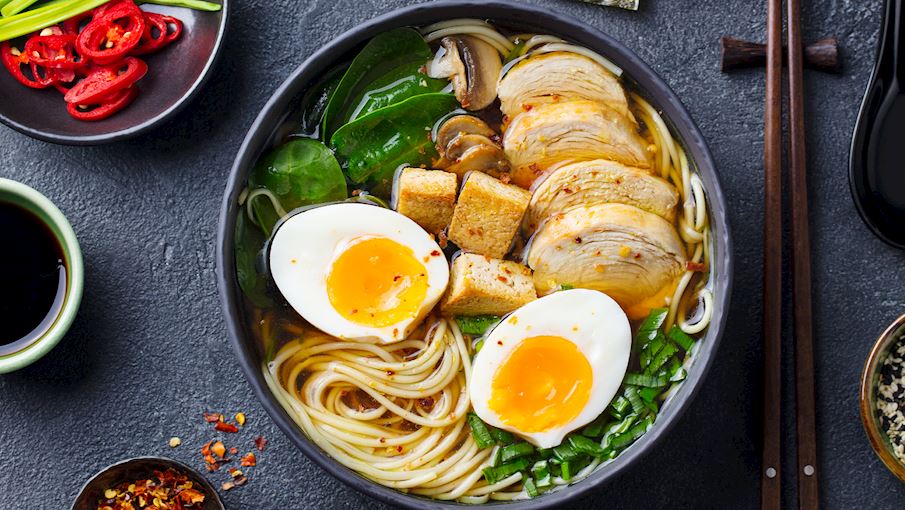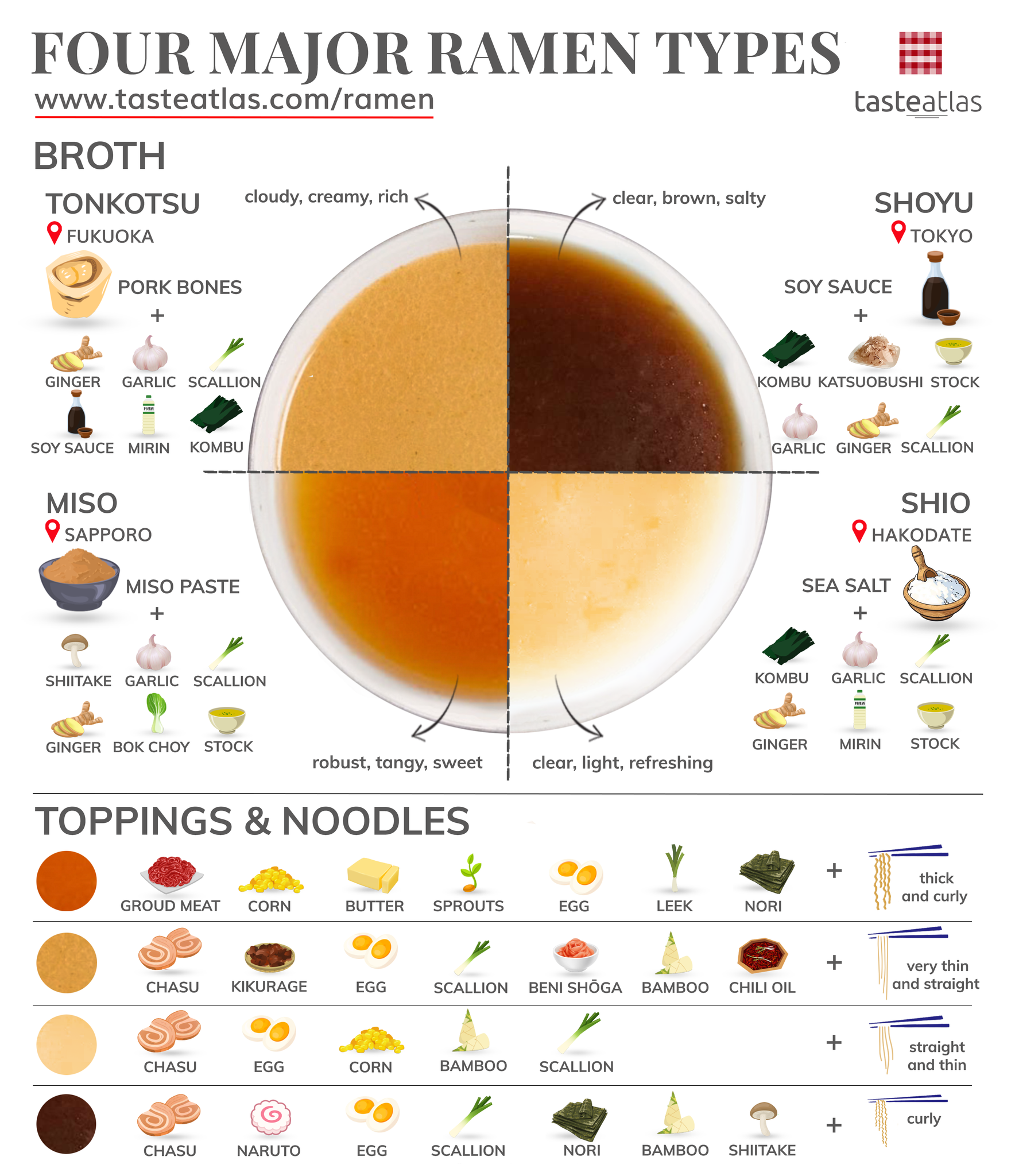MAIN INGREDIENTS
Ramen is a noodle soup that first appeared in Japan in 1910, when Chinese cooks combined the noodles with a salty broth. These curly noodles were of bright yellow color and more elastic than the Japanese noodles prepared at the time – the dough was kneaded with a sodium carbonate-infused mineral water called kansui.
In 1958, its name was derived from the pronunciation of the Chinese word lamian (pulled noodles), and that same year, Nissin Foods produced the first-ever instant version of noodles with a chicken-flavored broth called Chickin Ramen.
VARIATIONS OF Ramen
MOST ICONIC Ramen
View moreMAIN INGREDIENTS
Tonkotsu is a unique style of ramen consisting of an extremely rich, fatty pork broth, fresh noodles, soft-yolk eggs, and tender pork belly that melts in the mouth. It is so popular and special that it could be a dish of its own, not just a ramen style.
The ramen is usually topped with scallions for brightness and vibrancy, bamboo shoots for a crunchy, nutty flavor, nori seaweed for crispness, and sweet corn for an even better flavor. The rich broth is developed by cooking the pork bones for a very long time, until the collagen and fat dissolve, resulting in a unique, creamy texture of the dish.
VARIATIONS OF Tonkotsu ramen
MOST ICONIC Tonkotsu ramen
View moreMAIN INGREDIENTS
Yokohama-style ramen or iekei ramen is a Japanese type of ramen originating from the Yokohama area and dating back to 1974. The dish consists of thick noodles and a stock that's a mix of creamy tonkotsu (pork broth) and soy sauce. The toppings include chashu pork, chopped seaweed, leeks, and spinach.
There are also optional toppings and condiments such as minced garlic, sesame, preserved vegetables, and black pepper. The name of the dish means home-style ramen, and it was created by a former truck driver called Mr. Yoshimura, who'd opened his own ramen shop in 1974.
MAIN INGREDIENTS
Miso ramen is a flavorful dish made by cooking the miso base, broth, and vegetables in a wok. The concoction is then topped with bean sprouts, chopped pork, garlic, sweet corn, and (sometimes) local seafood such as crabs, scallops, and squids. The dish was invented in 1955 in Sapporo, when a customer in Aji no Sanpei noodle house asked the chef to put noodles in his pork and miso soup.
In the 1960s, miso ramen's popularity had skyrocketed, and Sapporo still remains a paradise for ramen lovers, taking pride in its Ramen Alley, with over a dozen ramen shops scattered through the street.
MOST ICONIC Miso ramen
View moreDistinguished by the use of salt as the main seasoning in the broth, shio ramen is one of the four main flavor-based ramen categories. Like other ramen varieties, it combines three crucial elements: flavorful broth, noodles, and various toppings.
Although pork is occasionally added, most versions employ seafood-based or chicken-based broths, which yield a light, clear soup with a strong, salty taste. The broth is usually paired with straight, thin noodles, and comes topped with Japanese-style pork belly known as chashu, scallions, hard boiled eggs, and wakame seaweed.
Since salt is the oldest known seasoning used in ramen, shio is considered to be the oldest version of ramen, and although there is no substantial evidence, many believe that it was invented in Hakodate, where it is still the prevalent ramen variety.
MOST ICONIC Shio ramen
View moreMAIN INGREDIENTS
Tsukemen is a noodle dish from Japan that is eaten in a unique way. Cold noodles are dipped in the accompanying soup, broth, or sauce, which are served hot in a separate bowl. The noodles can also be dipped in vinegar or spiced up with chili sauce before consumption.
Unlike ramen, where the boiled noodles are placed in the soup bowl, tsukemen is characterized by first washing the noodles with water, which stops them from expanding. It is said that tsukemen is ideal for summer because it provides the wonderful flavors of ramen without the extra heat.
MOST ICONIC Tsukemen
View moreMAIN INGREDIENTS
Hailing from Fukuoka, hakata is one of the most famous ramen variety in Japan. The base of the ramen is tonkotsu (which is why it is sometimes, especially in Fukoaka, refered to as tonkotsu ramen, although there are various other regional varieties of tonkotsu ramen), the creamy pork bone broth which gives the dish its incredibly rich and layered taste.
It is often only seasoned with shio (salt), and occasionally with shoyu (soy sauce) and miso (fermented soybean) paste. Hakata ramen is typically served with ultra-thin, straight, and firm wheat noodles, though it’s possible to choose the firmness of the noodles according to individual preferences.
MOST ICONIC Hakata ramen
View moreThe soy sauce based shoyu ramen is one of the four major groups of ramen - noodle dishes praised for their exquisite flavors. Noodles, broth, and various toppings are the three essential elements in every bowl of ramen. The dark and salty soup is what distinguishes shoyu from other varieties.
It usually employs meat or seafood broth, which is mixed with a fragrant combination of kombu stock and soy sauce. Fresh curly wheat noodles are typically used in shoyu ramen. Cooked separately, they are served in a bowl and doused in the rich broth.
VARIATIONS OF Shoyu ramen
MOST ICONIC Shoyu ramen
View moreMAIN INGREDIENTS
Curry udon consists of thick Japanese noodles made from wheat flour, served in a bowl of Japanese curry. Since it is a warming dish, curry udon is extremely popular during winter, and because things can get quite messy while consuming it, some curry udon restaurants offer disposable dibs to customers.
The dish can vary in levels of spiciness - from mild to hot, depending on the curry. One of the most popular toppings for the dish is Shabu Shabu meat, thinly sliced so that it combines extremely well with the thick and chewy udon noodles.
MOST ICONIC Karē udon
View moreUdon are thick and chewy Japanese noodles made from wheat flour. The noodles are round in shape and they have a firm and chewy texture. In their simplest form, udon noodles are served in kake udon, a noodle soup with a broth made with soy sauce, dashi, and mirin.
Although kake udon is served hot, the noodles can also be served in a cold broth, usually during the warmer seasons. The toppings for udon are also seasonal, and they include tempura-battered vegetables, shrimps, sliced spring onions, fried tofu, or rice cakes.
VARIATIONS OF Udon
MOST ICONIC Udon
View moreTasteAtlas food rankings are based on the ratings of the TasteAtlas audience, with a series of mechanisms that recognize real users and that ignore bot, nationalist or local patriotic ratings, and give additional value to the ratings of users that the system recognizes as knowledgeable. For the “Top 67 Japanese Noodle Dishes” list until March 21, 2025, 4,675 ratings were recorded, of which 3,937 were recognized by the system as legitimate. TasteAtlas Rankings should not be seen as the final global conclusion about food. Their purpose is to promote excellent local foods, instill pride in traditional dishes, and arouse curiosity about dishes you haven’t tried.



































































